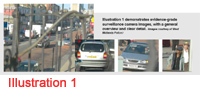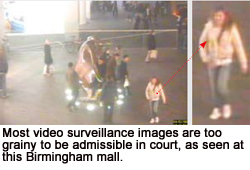As standards bodies debate video specifications, how well do these standards work for everyday applications? Lee Tracey, a security expert, examines whether video specifications deliver real results.
As standards bodies debate video specifications, how well do these standards work for everyday applications? Lee Tracey, a security expert, examines whether video specifications deliver real results.
I was asked to provide simple, intelligent commentary on international quality and performance specifications for video recording in the public sector. Now, I used to work in a forensic video analysis laboratory and the jaundiced opinion of my colleagues was that it is all crap and 80 percent is useless. In this article, I intend to be more constructive and informative.
A few years back, the British Home Office Scientific Development Branch produced a mighty tome on the technical merits and requirements for wearable camera and recorder systems. I could not fathom the thinking behind this publication at the time and I remain baffled now. It did not set out to raise the standards to the highest possible, but rather appeared to pander to the lowest, most easily achievable level. It set the resolution standard as 640 x 480, set the lens field-of-view (FOV) at 44 degrees, and required the system to recognize a vehicle license plate at seven meters. For me, that represents the bottom of the barrel — it is unacceptable today and certainly not a standard to be aspired to.
I believe that the standard specification should be set at the highest level current technology can achieve, and the commercial world invited to offer the closest they can get to the high specification. The winner would be the closest one while representing value for money. So what should that spec be?
There are three key factors: Overview, detail and frame rate.
The overview is to provide as much visual coverage as possible. In this respect, a 360-degree lens would be the perfect answer. The more practical FOV would be 120-degree, though many police officers asked for 180-degree because it would record a wide general view of how an incident was played out by various participants. A camera with a lens that provided more than 120 degrees could  cover a large area, so only one camera would be needed and save costs. The 120-degree lens would provide valuable information about what happened and how it went down. But if this camera was based on 640 x 480, or even the CVBS standard of 704 X 576, the detail per square yard would be so bad that even a mother would not recognize her favorite son. If the frame-rate is low — some installations offer as little as three images per second — then the forensic recovery chances are reduced.
cover a large area, so only one camera would be needed and save costs. The 120-degree lens would provide valuable information about what happened and how it went down. But if this camera was based on 640 x 480, or even the CVBS standard of 704 X 576, the detail per square yard would be so bad that even a mother would not recognize her favorite son. If the frame-rate is low — some installations offer as little as three images per second — then the forensic recovery chances are reduced.
To achieve simultaneous overview and detail for say a large parking lot — with conventional PAL/NTSC cameras up to 704 x 576 — would require both overview cameras (wide FOV) and narrow-view detail cameras covering small sections of the parking lot. To cover this parking lot, we would need about 30 cameras with normal CVBS 704 x 576 imagers and 22-degree FOV lenses for every overview camera. While some argue that 22 degrees is too narrow, the point is it will require many cameras with 640 x 480 or 702 x 576 resolution to acquire the detail needed to identify criminals.
So does the technology of 2010 provide us with the ability to achieve everything we need with just one camera? The answer is no! But we can do so with two cameras. The first would provide a low resolution overview at 25/30 fps, so we can see how the crime went down. The other would provide the detail. These two cameras could be built as one combined unit, nearly achieving the one-camera ideal. In Illustration 1, the camera that produced the image was built as a one-time experiment by the Forensic Video Laboratory of West Midlands Police in the U.K., dubbed "Goliath." West Midlands Police and Det. Sgt. Dannie Parkes received an award for this effort.
This brings us back full circle to what should be in a specification. As we know, technology can produce the results illustrated in Illustration 1, so should we insist on the "Goliath" specification and refuse all offerings that fail to reach this standard? I think that would be just as bad as listing the lower end of 640 x 480. My approach is to list the maximum that we know can be achieved, then judge who gets closest with the best value.
Evidence-Grade Surveillance
For the first quarter of 2010, the prime interest appears to be wearable camera/recorders for law enforcement use and other support services. A UK test carried out by the British Home Office Scientific Development Branch and the UK Devon and Cornwall Police concluded that the use of body-worn camera/recorders was a powerful tool in reducing attacks on officers and increasing the level of conviction success. So how should we write a specification for this type of equipment?
The first step is to decide what it is we wish to achieve. My interpretation of that objective is a still image on a piece of paper. This image clearly shows 'Orrible' Arry at the scene of the crime and is clear enough and positive enough to present as good evidence in a court of law. Other parameters I would apply are:
1. The lens must have a FOV of 120 degrees.
2. The original capture material must have been a video stream of 25/30 fps.
3. 'Orrible' Arry must be at a distance of 12 or more meters from the objective lens.
4. The print of 'Orrible' Arry must be from one specific image of the video stream.
There is no need to specify anything further concerning resolution and performance. There could be many other factors, such as size, weight, current consumption and features, but the objective is to identify 'Orrible' Arry.
 If such a specification is put out to tender, and one contractor can produce the results with an imager of 640 x 480 and a 120-degree lens, then that contractor deserves the contract. This holds even if a second contractor is offering 1920 x 1080 at 30 ips but cannot meet the requirement.
If such a specification is put out to tender, and one contractor can produce the results with an imager of 640 x 480 and a 120-degree lens, then that contractor deserves the contract. This holds even if a second contractor is offering 1920 x 1080 at 30 ips but cannot meet the requirement.
The argument that not every camera is fitted with a 120-degree FOV lens does not hold water. If the camera/ recorder combination can pass the 120-degree FOV test, then it will also pass others of equal rating.
We should not be asking contractors to quote against predetermined pixel standards but purely on their ability to deliver the required end result — positive identification of 'Orrible' Arry. If 10 contractors enter the tender, then the submission needs to be nothing more than an A4 print of the model, 'Orrible' Arry. Of the 10 A4 prints on the table, any that do not show a clear picture should be discarded, as anything else the vendor has to offer is irrelevant. The rest are then checked for compliance to the FOV, distance and video stream, then whittled down to the best value for money.
It is police experience and police practice to confront 'Orrible' Arry with a single image snapshot on a print. If it is clear and positive, the authorities go to trial with that evidence. Should the print be challenged, then more prints from the video stream can be produced. If challenged further, the entire video stream can be offered up. With just one snapshot taken from the video stream showing a clear image, the rest of the video stream will show much of the same. As many a criminal has found to their detriment, challenging a still picture and having the entire video stream shown to the jury can put them in a far worse position.
Where multiple suspects are involved in the same incident, a single print may be discarded in favor of the whole video stream. However, if we obtained a high quality print from the stream, the stream must be high quality as well. Therefore, the print is the reference standard to work from.
About the Author
Lee Tracey is a semiretired electronics engineer still active at the tender age of 84. He is currently assisting a UK start-up create a range of HD camera/recorder devices. Tracey was a former sergeant in the RAF Intelligence Corps codes/cyphers division in 1943. Since 1947, he was involved in law enforcement and intelligence technical support units.
Readers can contact Tracey at dvr@dsl.pipex.com.